Available with Location Referencing license.
Characteristics of a route can be represented as a point event offset from a location such as an intersection.
In the example below, a point event's measure is established using the location offset method. The route has start and end measure values of 0 and 10 miles, respectively. Event1 is located 2 miles from the intersection on the left and 8 miles from the intersection on the right.
Since the direction of calibration of the route is from left to right, the offset distance is calculated in the positive direction and the offset distance in the second case is shown as a negative number.
Add a point event by intersection offset
To add a point event using intersection offset, complete the following steps:
- Open the map in ArcGIS Pro and zoom in to the location where you want to add the point event.
- On the Location Referencing tab, in the Events group, click Add > Point Event
 .
.The Add Point Event pane appears with a Route and Measure value for Method as the default.
- Click the Method drop-down arrow and choose Location Offset.

- Click Next.
The Event Layer drop-down menu, the Network drop-down menu, and the Location Offset section appear in the pane.
- Click the Event Layer drop-down arrow and choose an event layer.
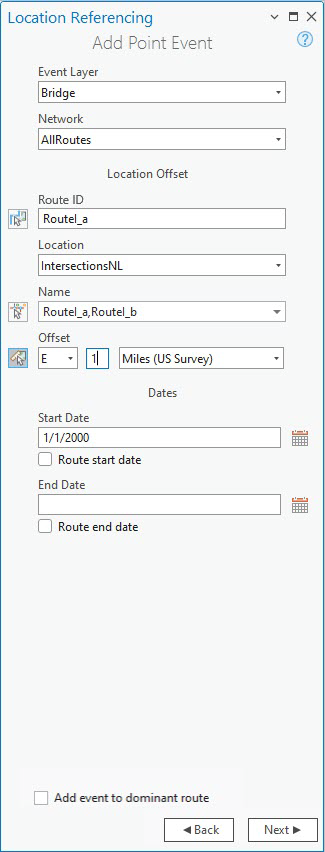
- Click the Location drop-down arrow and choose the intersection layer name.
All the intersection layers that are published with the map service and are registered with the parent LRS Network are listed.
- Specify the intersection name by doing one of the following:
- Type the intersection name in the Name text box.
- Click Choose location from map
 and click the intersection feature on the map to populate the Name text box.
and click the intersection feature on the map to populate the Name text box.
- Optionally, provide the Offset value for the location by doing one of the following:
- Click the Offset drop-down arrow to choose the offset direction, provide a measure value, and choose the units.
- Provide the measure value and choose the units.
- Click Choose offset from map
 and click a location along the route on the map.
and click a location along the route on the map.
A green dot appears at the offset location along the route on the map. This is the location of the measure value for the event.
- Specify the date that defines the start date of the event by doing one of the following:
- Provide the start date in the Start Date text box.
- Click Calendar
 and choose the start date.
and choose the start date. - Check the Route start date check box to use the route start date.
The start date default value is the current date, but you can choose a different date.
- Specify the date that defines the end date of the event by doing one of the following:
- Provide the end date in the End Date text box.
- Click the End Date drop-down arrow and choose the end date.
- Check the Route end date check box.
The end date is optional. If no end date is provided, the events remain valid from the event start date and into the future.
- Click Next
Attributes for the chosen event layer appear under Manage Attributes.
- Provide attribute information for the events in the attribute set.
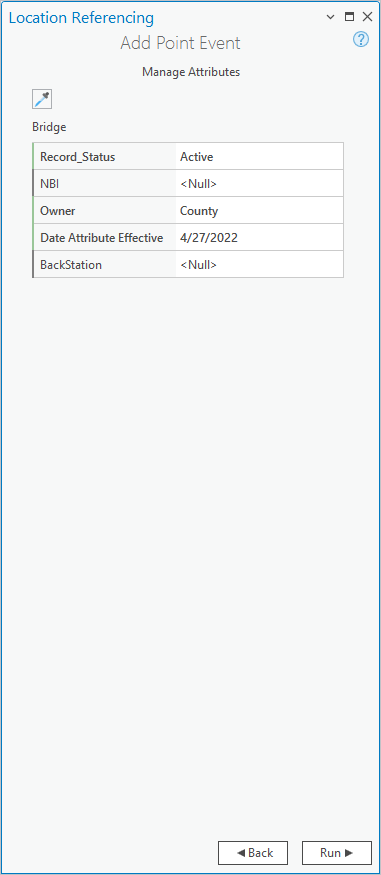
Note:
Click Copy attribute values by selecting event on the map
 and click an existing point event belonging to the same event layer on the map to copy event attributes from that event.
and click an existing point event belonging to the same event layer on the map to copy event attributes from that event. - Click Run.
A confirmation message appears once the newly added point event is created. The new point is created and appears on the map.
Add multiple point events by location offset
To add multiple point events using location offset, complete the following steps:
- Open the map in ArcGIS Pro and zoom to the location where you want to add the point events.
- On the Location Referencing tab, in the Events group, click Add > Multiple Point Events
 .
.The Add Multiple Point Events pane appears with a Route and Measure value for Method as the default.
- Click the Method drop-down arrow and choose Location Offset.
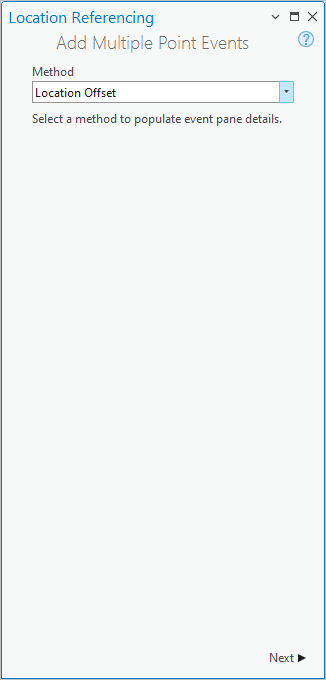
- Click Next.
The Event Layer drop-down menu, the Network drop-down menu, and the Location Offset section appear in the pane.
- Click the Network drop-down arrow and choose the parent LRS Network of the intersection layer to use as the location offset.
- Click the Location drop-down arrow and choose the intersection layer name.
All the intersection layers that are published with the map service and are registered with the parent LRS Network are listed.
- Specify the intersection name by doing one of the following:
- Provide the intersection name in the Name text box.
- Click Choose location from map
 and click the intersection feature on the map to populate the Name text box.
and click the intersection feature on the map to populate the Name text box.
- Optionally, specify the Offset direction for the referent offset by doing one of the following:
- Click the Offset drop-down arrow to choose the offset direction, provide the measure value, and choose the units.
- Provide the measure value and choose the units.
- Click Choose offset from map
 and click a location along the route on the map.
and click a location along the route on the map.
A green dot appears at the offset location along the route on the map. This is the location of the measure value for the event.
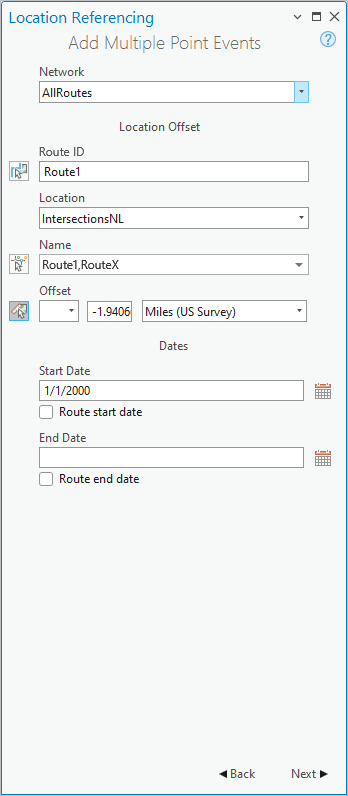
- Specify the date that defines the start date of the events by doing one of the following:
- Provide the start date in the Start Date text box.
- Click Calendar
 and choose the start date.
and choose the start date. - Check the Route start date check box to use the route start date.
Note:
The start date default value is today's date, but you can choose a different date.
- Specify the date that defines the end date of the event by doing one of the following:
- Provide the end date in the End Date text box.
- Click the End Date drop-down arrow and choose the end date.
- Check the Route end date check box.
The end date is optional. If no end date is provided, the events remain valid from the event start date and into the future.
- Click Next.
Manage Attributes appears.
The Attribute Set drop-down menu includes other attribute sets if configured for the parent LRS Network.
- Optionally, choose an attribute from the Attribute Set drop-down list.
- Provide attribute information for the events in the attribute set.
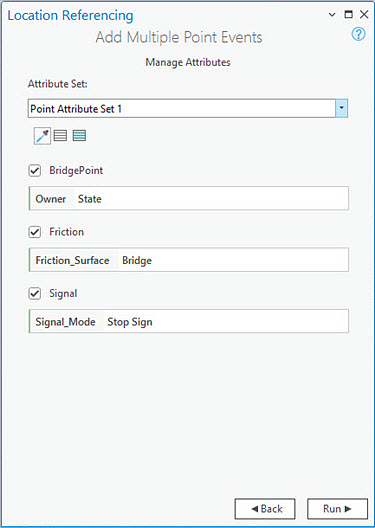
Note:
Click Copy attribute values by selecting event on the map
 and click an existing point event belonging to the same event layer on the map to copy event attributes from that event.
and click an existing point event belonging to the same event layer on the map to copy event attributes from that event. - Click Run.
A confirmation message appears once the newly added point events are created. The new points are created and appear on the map.
Referent offset when using the location offset method
The Roads and Highways events data model supports the configuration of referent fields and their enablement using the Enable Referent Fields tool. Once referent fields are configured and enabled in a layer, referent locations are populated and persisted in that layer when events are added or edited.
When point events are created using the location offset method in a referent-enabled layer, the intersection layer's name is used as the RefMethod value, and the intersection ID is used as the RefLocation value.
If the measure of a point event is updated, the RefOffset value updates to reflect the new value.
The examples below demonstrate the impact of adding point event records to a layer that has referent values enabled.
Before adding a point event with referents
In the following diagram, Route1 has measures from 0 to 10 and no associated event:
The following table provides details about the route:
| Route ID | From Date | To Date |
|---|---|---|
Route1 | 1/1/2000 | <Null> |
After adding a point event with referents
In the following diagram, a point event that has referents has been added at measure 6:
The following table provides details about the referent-enabled fields after event creation:
| RefMethod | RefLocation | RefOffset |
|---|---|---|
IntersectionLayer | Intersection1 | 3 |
The following table provides details about the default event attributes after event creation:
| Event ID | Route ID | From Date | To Date | Measure |
|---|---|---|---|---|
Event1 | Route1 | 1/1/2000 | <Null> | 6 |
You can edit the event using the attribute table so that it uses referents other than the default values. If subsequent route edits are made, the RefMethod and RefLocation values revert to the parent LRS Network and the route, respectively.
Before adding multiple point events with referents
When multiple point events are created using the coordinates method in a referent-enabled layer, X/Y is used as the RefMethod value, and the geographic coordinates are used as the RefLocation value.
The following diagram shows the route before events are created:
The following table provides details about the route:
| Route ID | From Date | To Date |
|---|---|---|
Route1 | 1/1/2000 | <Null> |
After adding multiple point events with referents
The following diagram shows multiple point events that have been added to point event layers that have referents enabled:
The following table provides details about the event referent fields in each of the event layers after event creation:
| RefMethod | RefLocation | RefOffset |
|---|---|---|
IntersectionLayer | Intersection1 | 3 |
The following table provides details about the default event fields after event creation:
Bridge
| Event ID | From Date | To Date | Route ID | Measure |
|---|---|---|---|---|
Event1 | 1/1/2000 | <Null> | Route1 | 6 |
Signal
| Event ID | From Date | To Date | Route ID | Measure |
|---|---|---|---|---|
Event1 | 1/1/2000 | <Null> | Route1 | 6 |
Friction
| Event ID | From Date | To Date | Route ID | Measure |
|---|---|---|---|---|
Event1 | 1/1/2000 | <Null> | Route1 | 6 |
The Roads and Highways events data model supports the configuration of referent event fields and their enablement using the Enable Referent Fields tool. Once referent fields are configured and enabled in a layer, referents are populated in that layer when events are added or edited using ArcGIS Pro.